Bushfire Construction: Standards and Materials in Prone Areas
VerifiedAdded on 2023/06/03
|12
|3066
|80
Report
AI Summary
This report provides an analysis of building standards in bushfire-prone areas, focusing on the legal frameworks and construction materials required to enhance the capacity of structures to withstand bushfire attacks. It reviews the Australian Standard AS 3959-2009 and its amendments, emphasizing the importance of determining the Bushfire Attack Level (BAL) and using tested construction materials. The report also discusses the benefits of using tested construction materials, new technologies and products, BIM knowledge, and the importance of using accredited practitioners. It highlights the significance of property owners and designers utilizing trained, proficient experts during the planning, approval, and development process in bushfire-prone areas, referencing the Fire Protection Association Australia's Bushfire Planning and Design Accreditation Scheme (BPAD).
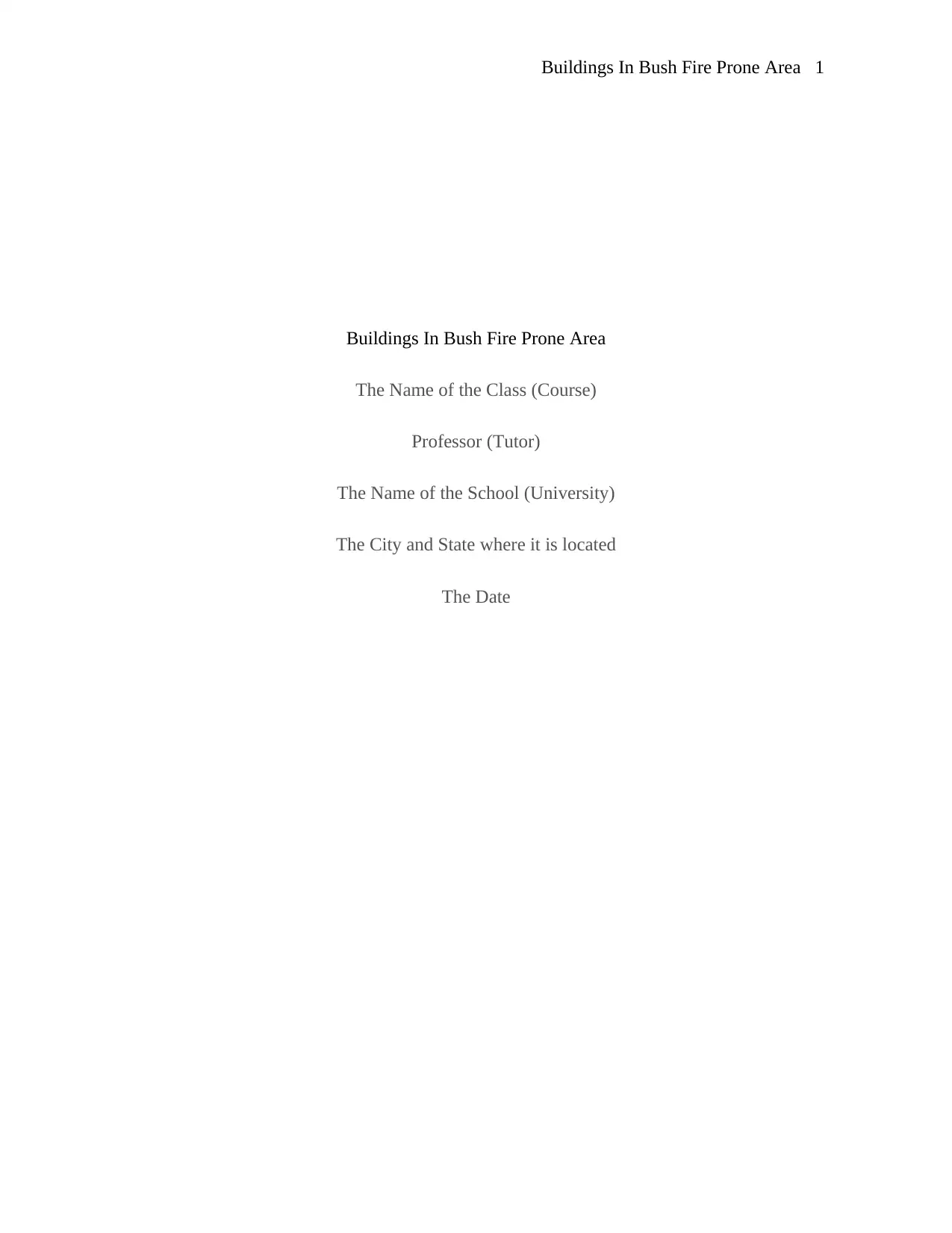
Buildings In Bush Fire Prone Area 1
Buildings In Bush Fire Prone Area
The Name of the Class (Course)
Professor (Tutor)
The Name of the School (University)
The City and State where it is located
The Date
Buildings In Bush Fire Prone Area
The Name of the Class (Course)
Professor (Tutor)
The Name of the School (University)
The City and State where it is located
The Date
Paraphrase This Document
Need a fresh take? Get an instant paraphrase of this document with our AI Paraphraser
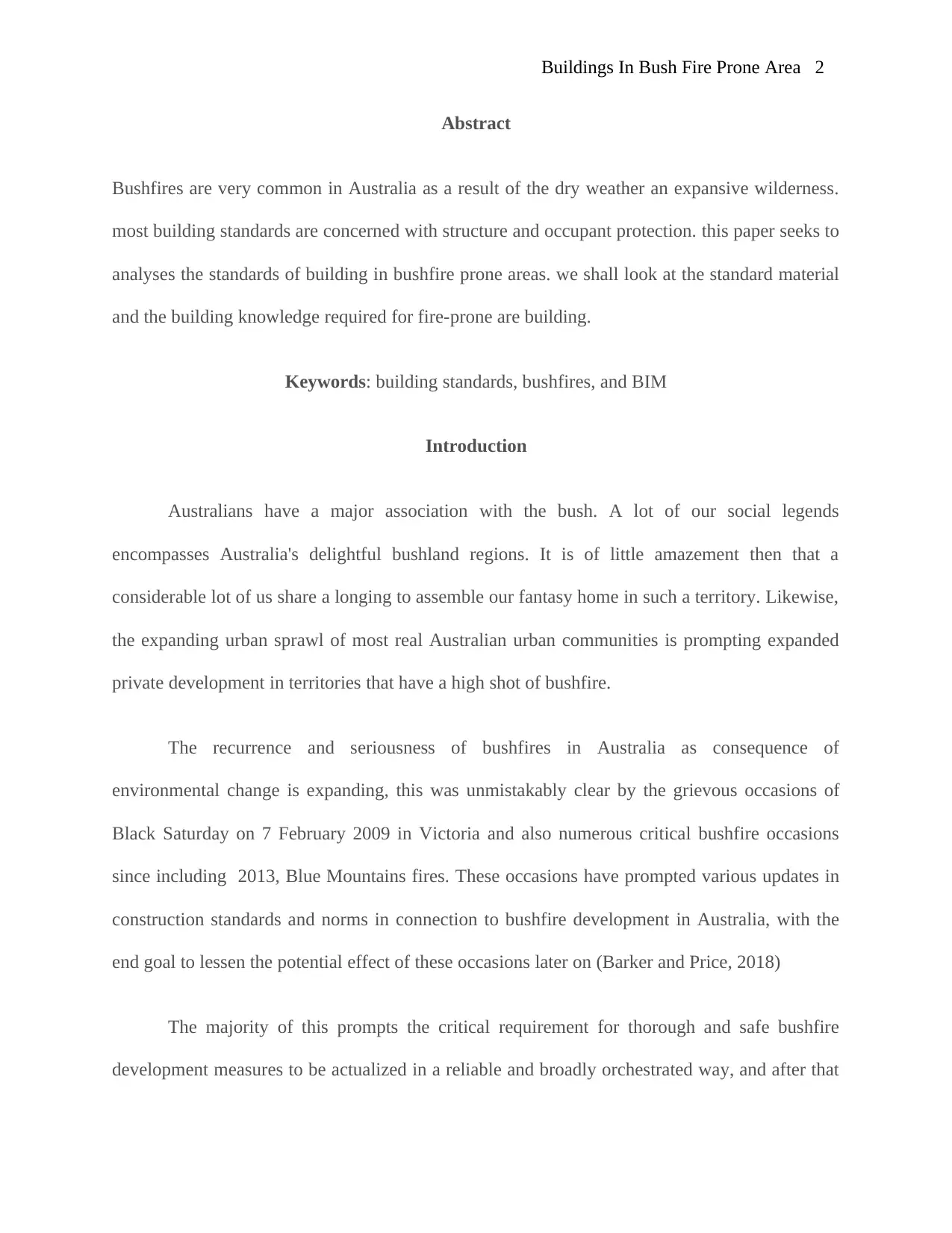
Buildings In Bush Fire Prone Area 2
Abstract
Bushfires are very common in Australia as a result of the dry weather an expansive wilderness.
most building standards are concerned with structure and occupant protection. this paper seeks to
analyses the standards of building in bushfire prone areas. we shall look at the standard material
and the building knowledge required for fire-prone are building.
Keywords: building standards, bushfires, and BIM
Introduction
Australians have a major association with the bush. A lot of our social legends
encompasses Australia's delightful bushland regions. It is of little amazement then that a
considerable lot of us share a longing to assemble our fantasy home in such a territory. Likewise,
the expanding urban sprawl of most real Australian urban communities is prompting expanded
private development in territories that have a high shot of bushfire.
The recurrence and seriousness of bushfires in Australia as consequence of
environmental change is expanding, this was unmistakably clear by the grievous occasions of
Black Saturday on 7 February 2009 in Victoria and also numerous critical bushfire occasions
since including 2013, Blue Mountains fires. These occasions have prompted various updates in
construction standards and norms in connection to bushfire development in Australia, with the
end goal to lessen the potential effect of these occasions later on (Barker and Price, 2018)
The majority of this prompts the critical requirement for thorough and safe bushfire
development measures to be actualized in a reliable and broadly orchestrated way, and after that
Abstract
Bushfires are very common in Australia as a result of the dry weather an expansive wilderness.
most building standards are concerned with structure and occupant protection. this paper seeks to
analyses the standards of building in bushfire prone areas. we shall look at the standard material
and the building knowledge required for fire-prone are building.
Keywords: building standards, bushfires, and BIM
Introduction
Australians have a major association with the bush. A lot of our social legends
encompasses Australia's delightful bushland regions. It is of little amazement then that a
considerable lot of us share a longing to assemble our fantasy home in such a territory. Likewise,
the expanding urban sprawl of most real Australian urban communities is prompting expanded
private development in territories that have a high shot of bushfire.
The recurrence and seriousness of bushfires in Australia as consequence of
environmental change is expanding, this was unmistakably clear by the grievous occasions of
Black Saturday on 7 February 2009 in Victoria and also numerous critical bushfire occasions
since including 2013, Blue Mountains fires. These occasions have prompted various updates in
construction standards and norms in connection to bushfire development in Australia, with the
end goal to lessen the potential effect of these occasions later on (Barker and Price, 2018)
The majority of this prompts the critical requirement for thorough and safe bushfire
development measures to be actualized in a reliable and broadly orchestrated way, and after that
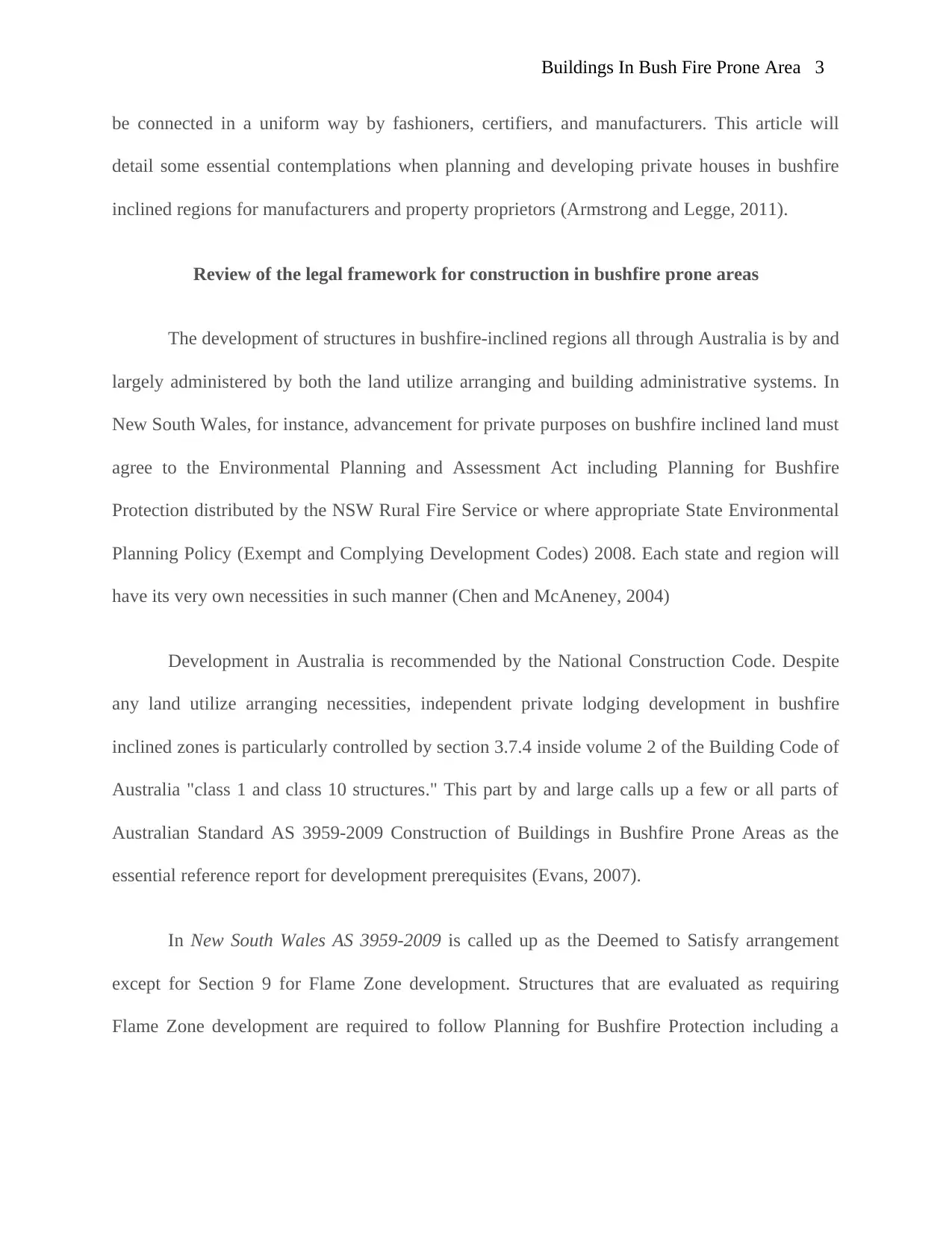
Buildings In Bush Fire Prone Area 3
be connected in a uniform way by fashioners, certifiers, and manufacturers. This article will
detail some essential contemplations when planning and developing private houses in bushfire
inclined regions for manufacturers and property proprietors (Armstrong and Legge, 2011).
Review of the legal framework for construction in bushfire prone areas
The development of structures in bushfire-inclined regions all through Australia is by and
largely administered by both the land utilize arranging and building administrative systems. In
New South Wales, for instance, advancement for private purposes on bushfire inclined land must
agree to the Environmental Planning and Assessment Act including Planning for Bushfire
Protection distributed by the NSW Rural Fire Service or where appropriate State Environmental
Planning Policy (Exempt and Complying Development Codes) 2008. Each state and region will
have its very own necessities in such manner (Chen and McAneney, 2004)
Development in Australia is recommended by the National Construction Code. Despite
any land utilize arranging necessities, independent private lodging development in bushfire
inclined zones is particularly controlled by section 3.7.4 inside volume 2 of the Building Code of
Australia "class 1 and class 10 structures." This part by and large calls up a few or all parts of
Australian Standard AS 3959-2009 Construction of Buildings in Bushfire Prone Areas as the
essential reference report for development prerequisites (Evans, 2007).
In New South Wales AS 3959-2009 is called up as the Deemed to Satisfy arrangement
except for Section 9 for Flame Zone development. Structures that are evaluated as requiring
Flame Zone development are required to follow Planning for Bushfire Protection including a
be connected in a uniform way by fashioners, certifiers, and manufacturers. This article will
detail some essential contemplations when planning and developing private houses in bushfire
inclined regions for manufacturers and property proprietors (Armstrong and Legge, 2011).
Review of the legal framework for construction in bushfire prone areas
The development of structures in bushfire-inclined regions all through Australia is by and
largely administered by both the land utilize arranging and building administrative systems. In
New South Wales, for instance, advancement for private purposes on bushfire inclined land must
agree to the Environmental Planning and Assessment Act including Planning for Bushfire
Protection distributed by the NSW Rural Fire Service or where appropriate State Environmental
Planning Policy (Exempt and Complying Development Codes) 2008. Each state and region will
have its very own necessities in such manner (Chen and McAneney, 2004)
Development in Australia is recommended by the National Construction Code. Despite
any land utilize arranging necessities, independent private lodging development in bushfire
inclined zones is particularly controlled by section 3.7.4 inside volume 2 of the Building Code of
Australia "class 1 and class 10 structures." This part by and large calls up a few or all parts of
Australian Standard AS 3959-2009 Construction of Buildings in Bushfire Prone Areas as the
essential reference report for development prerequisites (Evans, 2007).
In New South Wales AS 3959-2009 is called up as the Deemed to Satisfy arrangement
except for Section 9 for Flame Zone development. Structures that are evaluated as requiring
Flame Zone development are required to follow Planning for Bushfire Protection including a
⊘ This is a preview!⊘
Do you want full access?
Subscribe today to unlock all pages.

Trusted by 1+ million students worldwide

Buildings In Bush Fire Prone Area 4
particular estimate required by the Rural Fire Service through a Bushfire Safety Authority which
shapes some portion of the Development Approval for the land.
While the standard is for the most part connected over all states and domains in Australia,
the manner in which it is executed may differ depending on the prerequisites of different bits of
important enactment. These state-based controls essentially shift the arranging
prerequisites/instruments required for applying the standard and may change components of the
Standard, be that as it may, when in doubt the generally speaking the necessities of AS 3959 is in
a general sense the equivalent crosswise over Australian purviews (Cansler and Larson, 2013).
A critical segment of development in bushfire inclined zones is deciding the Bushfire
Attack Level (BAL). The BAL is resolved through consolidating the estimations of a scope of
estimations including the Fire Danger Rating for a given territory, the vegetation arrangement,
separation of proposed constructing site from vegetation and compelling incline of the land
proposed for advancement. There are five Bushfire Attack Levels as pursues:
BAL-12.5,
BAL-19,
BAL-29,
BAL 40 and
BAL-FZ.
particular estimate required by the Rural Fire Service through a Bushfire Safety Authority which
shapes some portion of the Development Approval for the land.
While the standard is for the most part connected over all states and domains in Australia,
the manner in which it is executed may differ depending on the prerequisites of different bits of
important enactment. These state-based controls essentially shift the arranging
prerequisites/instruments required for applying the standard and may change components of the
Standard, be that as it may, when in doubt the generally speaking the necessities of AS 3959 is in
a general sense the equivalent crosswise over Australian purviews (Cansler and Larson, 2013).
A critical segment of development in bushfire inclined zones is deciding the Bushfire
Attack Level (BAL). The BAL is resolved through consolidating the estimations of a scope of
estimations including the Fire Danger Rating for a given territory, the vegetation arrangement,
separation of proposed constructing site from vegetation and compelling incline of the land
proposed for advancement. There are five Bushfire Attack Levels as pursues:
BAL-12.5,
BAL-19,
BAL-29,
BAL 40 and
BAL-FZ.
Paraphrase This Document
Need a fresh take? Get an instant paraphrase of this document with our AI Paraphraser
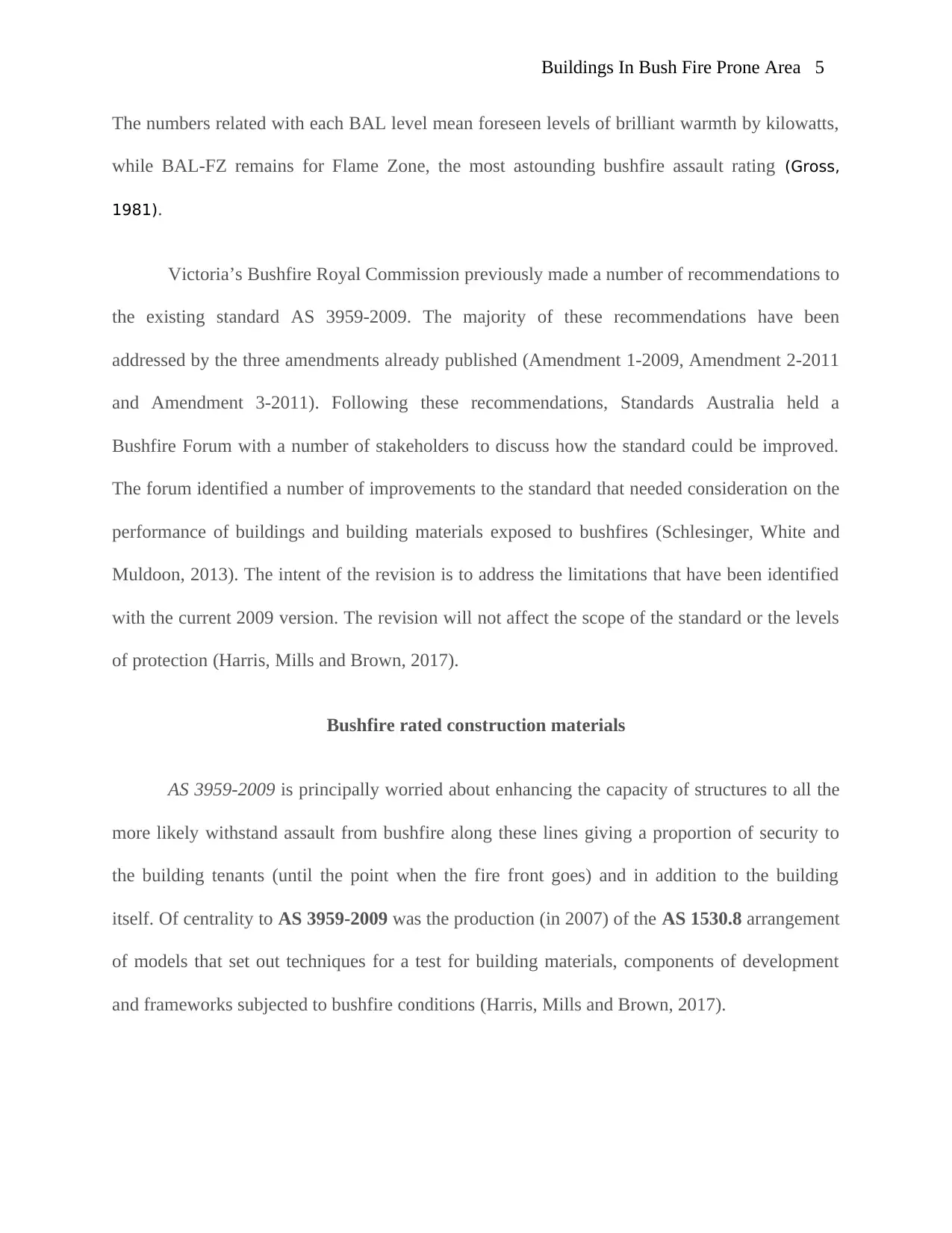
Buildings In Bush Fire Prone Area 5
The numbers related with each BAL level mean foreseen levels of brilliant warmth by kilowatts,
while BAL-FZ remains for Flame Zone, the most astounding bushfire assault rating (Gross,
1981).
Victoria’s Bushfire Royal Commission previously made a number of recommendations to
the existing standard AS 3959-2009. The majority of these recommendations have been
addressed by the three amendments already published (Amendment 1-2009, Amendment 2-2011
and Amendment 3-2011). Following these recommendations, Standards Australia held a
Bushfire Forum with a number of stakeholders to discuss how the standard could be improved.
The forum identified a number of improvements to the standard that needed consideration on the
performance of buildings and building materials exposed to bushfires (Schlesinger, White and
Muldoon, 2013). The intent of the revision is to address the limitations that have been identified
with the current 2009 version. The revision will not affect the scope of the standard or the levels
of protection (Harris, Mills and Brown, 2017).
Bushfire rated construction materials
AS 3959-2009 is principally worried about enhancing the capacity of structures to all the
more likely withstand assault from bushfire along these lines giving a proportion of security to
the building tenants (until the point when the fire front goes) and in addition to the building
itself. Of centrality to AS 3959-2009 was the production (in 2007) of the AS 1530.8 arrangement
of models that set out techniques for a test for building materials, components of development
and frameworks subjected to bushfire conditions (Harris, Mills and Brown, 2017).
The numbers related with each BAL level mean foreseen levels of brilliant warmth by kilowatts,
while BAL-FZ remains for Flame Zone, the most astounding bushfire assault rating (Gross,
1981).
Victoria’s Bushfire Royal Commission previously made a number of recommendations to
the existing standard AS 3959-2009. The majority of these recommendations have been
addressed by the three amendments already published (Amendment 1-2009, Amendment 2-2011
and Amendment 3-2011). Following these recommendations, Standards Australia held a
Bushfire Forum with a number of stakeholders to discuss how the standard could be improved.
The forum identified a number of improvements to the standard that needed consideration on the
performance of buildings and building materials exposed to bushfires (Schlesinger, White and
Muldoon, 2013). The intent of the revision is to address the limitations that have been identified
with the current 2009 version. The revision will not affect the scope of the standard or the levels
of protection (Harris, Mills and Brown, 2017).
Bushfire rated construction materials
AS 3959-2009 is principally worried about enhancing the capacity of structures to all the
more likely withstand assault from bushfire along these lines giving a proportion of security to
the building tenants (until the point when the fire front goes) and in addition to the building
itself. Of centrality to AS 3959-2009 was the production (in 2007) of the AS 1530.8 arrangement
of models that set out techniques for a test for building materials, components of development
and frameworks subjected to bushfire conditions (Harris, Mills and Brown, 2017).
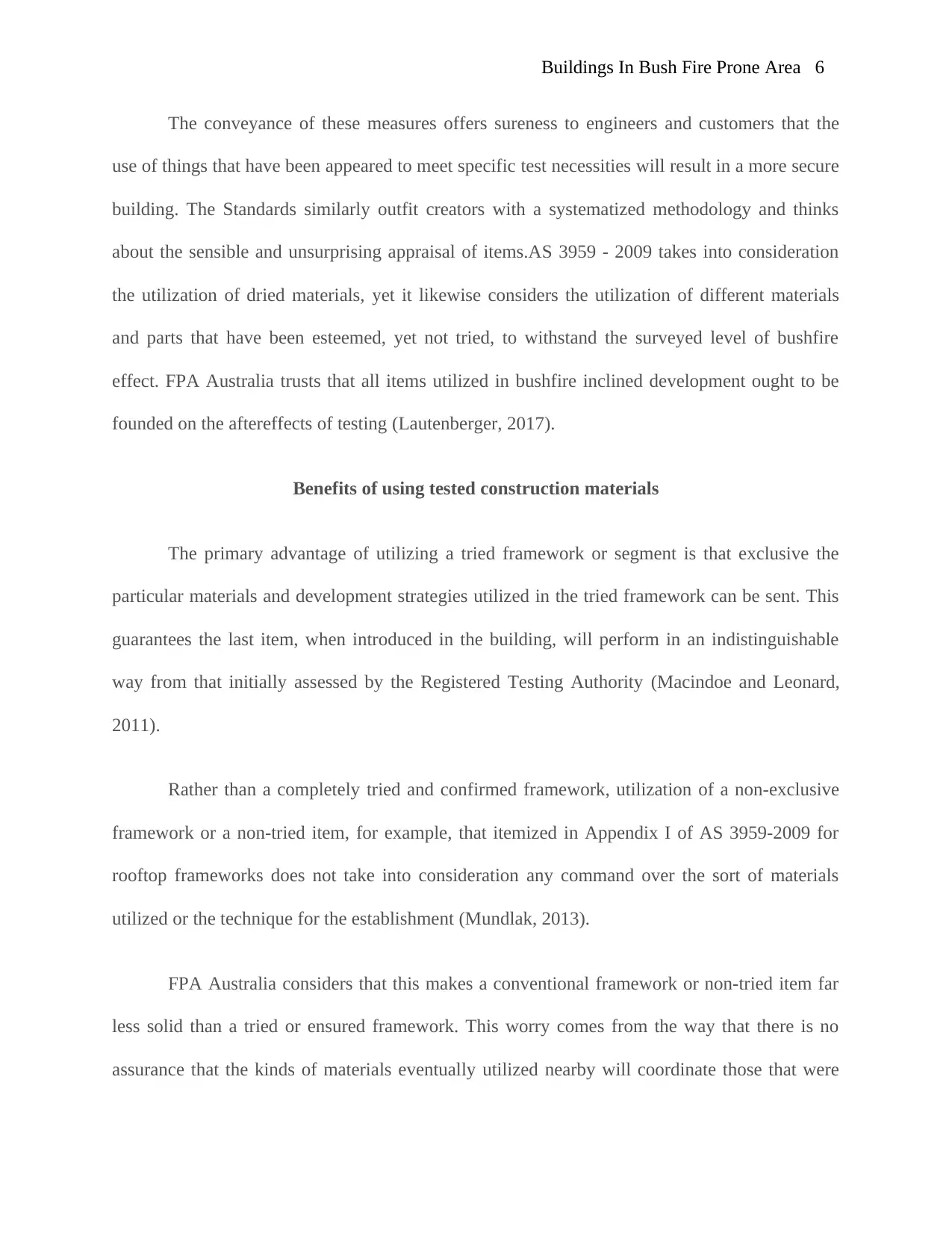
Buildings In Bush Fire Prone Area 6
The conveyance of these measures offers sureness to engineers and customers that the
use of things that have been appeared to meet specific test necessities will result in a more secure
building. The Standards similarly outfit creators with a systematized methodology and thinks
about the sensible and unsurprising appraisal of items.AS 3959 - 2009 takes into consideration
the utilization of dried materials, yet it likewise considers the utilization of different materials
and parts that have been esteemed, yet not tried, to withstand the surveyed level of bushfire
effect. FPA Australia trusts that all items utilized in bushfire inclined development ought to be
founded on the aftereffects of testing (Lautenberger, 2017).
Benefits of using tested construction materials
The primary advantage of utilizing a tried framework or segment is that exclusive the
particular materials and development strategies utilized in the tried framework can be sent. This
guarantees the last item, when introduced in the building, will perform in an indistinguishable
way from that initially assessed by the Registered Testing Authority (Macindoe and Leonard,
2011).
Rather than a completely tried and confirmed framework, utilization of a non-exclusive
framework or a non-tried item, for example, that itemized in Appendix I of AS 3959-2009 for
rooftop frameworks does not take into consideration any command over the sort of materials
utilized or the technique for the establishment (Mundlak, 2013).
FPA Australia considers that this makes a conventional framework or non-tried item far
less solid than a tried or ensured framework. This worry comes from the way that there is no
assurance that the kinds of materials eventually utilized nearby will coordinate those that were
The conveyance of these measures offers sureness to engineers and customers that the
use of things that have been appeared to meet specific test necessities will result in a more secure
building. The Standards similarly outfit creators with a systematized methodology and thinks
about the sensible and unsurprising appraisal of items.AS 3959 - 2009 takes into consideration
the utilization of dried materials, yet it likewise considers the utilization of different materials
and parts that have been esteemed, yet not tried, to withstand the surveyed level of bushfire
effect. FPA Australia trusts that all items utilized in bushfire inclined development ought to be
founded on the aftereffects of testing (Lautenberger, 2017).
Benefits of using tested construction materials
The primary advantage of utilizing a tried framework or segment is that exclusive the
particular materials and development strategies utilized in the tried framework can be sent. This
guarantees the last item, when introduced in the building, will perform in an indistinguishable
way from that initially assessed by the Registered Testing Authority (Macindoe and Leonard,
2011).
Rather than a completely tried and confirmed framework, utilization of a non-exclusive
framework or a non-tried item, for example, that itemized in Appendix I of AS 3959-2009 for
rooftop frameworks does not take into consideration any command over the sort of materials
utilized or the technique for the establishment (Mundlak, 2013).
FPA Australia considers that this makes a conventional framework or non-tried item far
less solid than a tried or ensured framework. This worry comes from the way that there is no
assurance that the kinds of materials eventually utilized nearby will coordinate those that were
⊘ This is a preview!⊘
Do you want full access?
Subscribe today to unlock all pages.

Trusted by 1+ million students worldwide
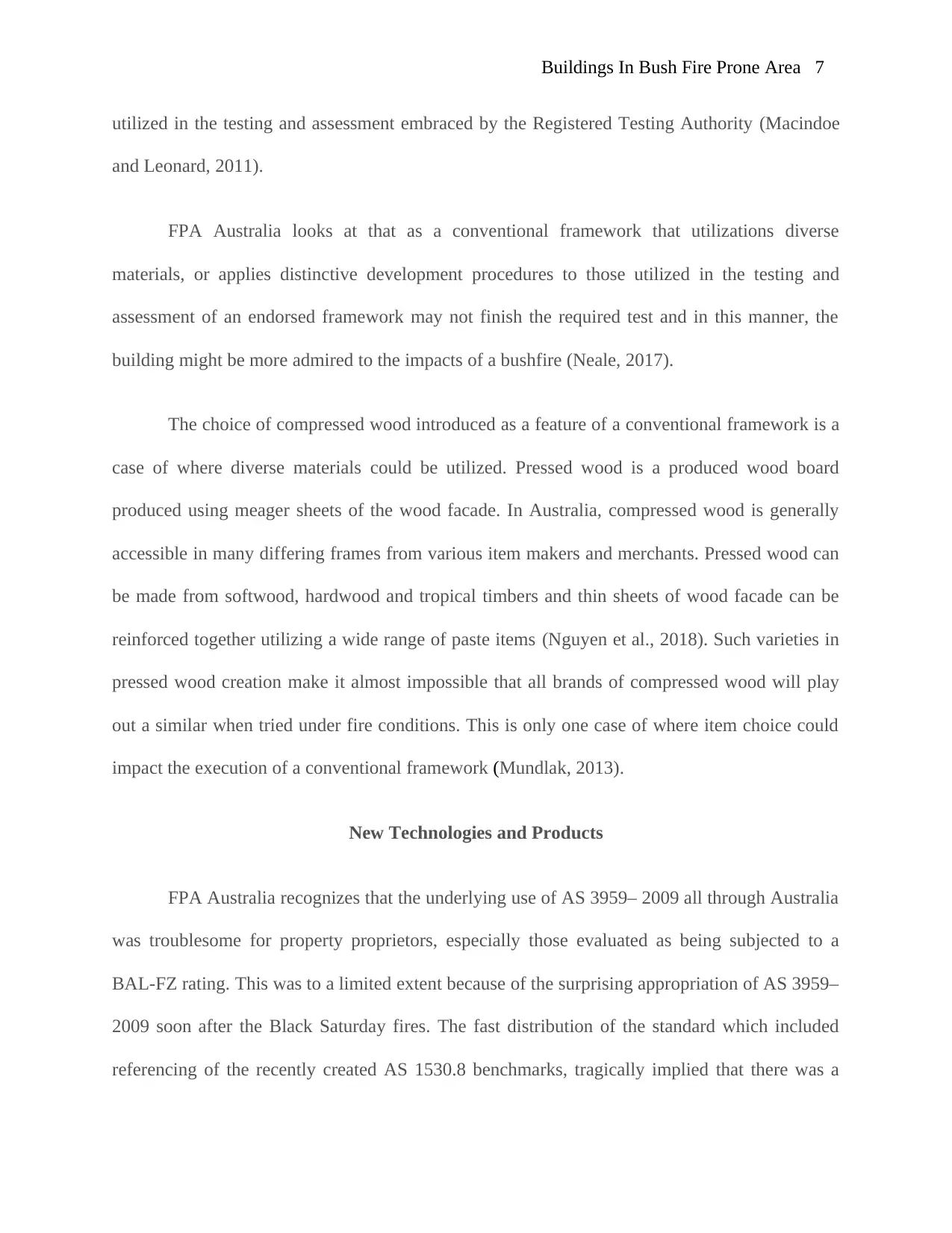
Buildings In Bush Fire Prone Area 7
utilized in the testing and assessment embraced by the Registered Testing Authority (Macindoe
and Leonard, 2011).
FPA Australia looks at that as a conventional framework that utilizations diverse
materials, or applies distinctive development procedures to those utilized in the testing and
assessment of an endorsed framework may not finish the required test and in this manner, the
building might be more admired to the impacts of a bushfire (Neale, 2017).
The choice of compressed wood introduced as a feature of a conventional framework is a
case of where diverse materials could be utilized. Pressed wood is a produced wood board
produced using meager sheets of the wood facade. In Australia, compressed wood is generally
accessible in many differing frames from various item makers and merchants. Pressed wood can
be made from softwood, hardwood and tropical timbers and thin sheets of wood facade can be
reinforced together utilizing a wide range of paste items (Nguyen et al., 2018). Such varieties in
pressed wood creation make it almost impossible that all brands of compressed wood will play
out a similar when tried under fire conditions. This is only one case of where item choice could
impact the execution of a conventional framework (Mundlak, 2013).
New Technologies and Products
FPA Australia recognizes that the underlying use of AS 3959– 2009 all through Australia
was troublesome for property proprietors, especially those evaluated as being subjected to a
BAL-FZ rating. This was to a limited extent because of the surprising appropriation of AS 3959–
2009 soon after the Black Saturday fires. The fast distribution of the standard which included
referencing of the recently created AS 1530.8 benchmarks, tragically implied that there was a
utilized in the testing and assessment embraced by the Registered Testing Authority (Macindoe
and Leonard, 2011).
FPA Australia looks at that as a conventional framework that utilizations diverse
materials, or applies distinctive development procedures to those utilized in the testing and
assessment of an endorsed framework may not finish the required test and in this manner, the
building might be more admired to the impacts of a bushfire (Neale, 2017).
The choice of compressed wood introduced as a feature of a conventional framework is a
case of where diverse materials could be utilized. Pressed wood is a produced wood board
produced using meager sheets of the wood facade. In Australia, compressed wood is generally
accessible in many differing frames from various item makers and merchants. Pressed wood can
be made from softwood, hardwood and tropical timbers and thin sheets of wood facade can be
reinforced together utilizing a wide range of paste items (Nguyen et al., 2018). Such varieties in
pressed wood creation make it almost impossible that all brands of compressed wood will play
out a similar when tried under fire conditions. This is only one case of where item choice could
impact the execution of a conventional framework (Mundlak, 2013).
New Technologies and Products
FPA Australia recognizes that the underlying use of AS 3959– 2009 all through Australia
was troublesome for property proprietors, especially those evaluated as being subjected to a
BAL-FZ rating. This was to a limited extent because of the surprising appropriation of AS 3959–
2009 soon after the Black Saturday fires. The fast distribution of the standard which included
referencing of the recently created AS 1530.8 benchmarks, tragically implied that there was a
Paraphrase This Document
Need a fresh take? Get an instant paraphrase of this document with our AI Paraphraser

Buildings In Bush Fire Prone Area 8
little open door for items to be produced and tried to conform to the new test standard (Neale,
2017)
In spite of the issues related to the underlying production of the standard, business has
reacted by contributing significant assets to outline and test frameworks to meet the new
necessities. Indeed, the quick arrival of the standard supported development, as well as
characterized a normal level of execution and a notwithstanding playing field. This has brought
about an expanded, yet the proper level of insurance for the network (Cary et al,2009).
Referencing the AS 1530.8 arrangement of measures as a benchmark prerequisite has
made an interest for a tried item that industry has reacted to and keeps on advancing towards.
Different items that have been tried to and found to consent to the test principles are presently
accessible in the commercial center (Wardoyo et al., 2007).
Property holders have a privilege to expect that plan and development to a specific
surveyed BAL level means only that. Any open door for a decrease in execution, unintentionally
or generally using nonexclusive frameworks or untested items ought to be painstakingly
considered to guarantee buyer and network wellbeing is regarded as the need while deciding
development in bushfire inclined regions (Nguyen et al., 2018).
BIM knowledge
Standards and Measures Australia facilitated the dispatch of the BIM Knowledge and
Skills Framework for the benefit of the Australasian Procurement and Construction Council and
Australian Construction Industry Forum prior this year. This key gathering united key partners
from the Australasian building and development industry. As an individual from the Australasian
little open door for items to be produced and tried to conform to the new test standard (Neale,
2017)
In spite of the issues related to the underlying production of the standard, business has
reacted by contributing significant assets to outline and test frameworks to meet the new
necessities. Indeed, the quick arrival of the standard supported development, as well as
characterized a normal level of execution and a notwithstanding playing field. This has brought
about an expanded, yet the proper level of insurance for the network (Cary et al,2009).
Referencing the AS 1530.8 arrangement of measures as a benchmark prerequisite has
made an interest for a tried item that industry has reacted to and keeps on advancing towards.
Different items that have been tried to and found to consent to the test principles are presently
accessible in the commercial center (Wardoyo et al., 2007).
Property holders have a privilege to expect that plan and development to a specific
surveyed BAL level means only that. Any open door for a decrease in execution, unintentionally
or generally using nonexclusive frameworks or untested items ought to be painstakingly
considered to guarantee buyer and network wellbeing is regarded as the need while deciding
development in bushfire inclined regions (Nguyen et al., 2018).
BIM knowledge
Standards and Measures Australia facilitated the dispatch of the BIM Knowledge and
Skills Framework for the benefit of the Australasian Procurement and Construction Council and
Australian Construction Industry Forum prior this year. This key gathering united key partners
from the Australasian building and development industry. As an individual from the Australasian
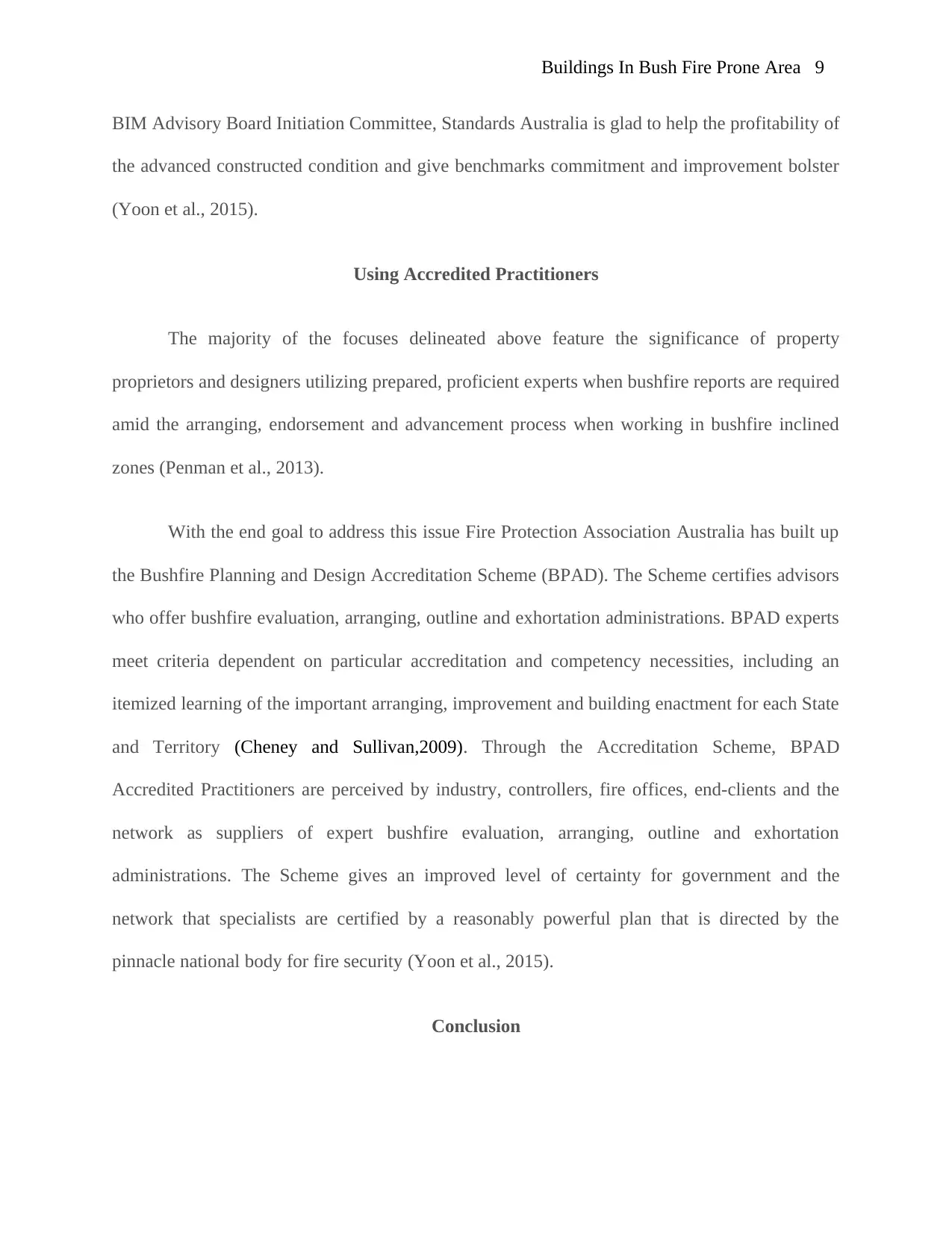
Buildings In Bush Fire Prone Area 9
BIM Advisory Board Initiation Committee, Standards Australia is glad to help the profitability of
the advanced constructed condition and give benchmarks commitment and improvement bolster
(Yoon et al., 2015).
Using Accredited Practitioners
The majority of the focuses delineated above feature the significance of property
proprietors and designers utilizing prepared, proficient experts when bushfire reports are required
amid the arranging, endorsement and advancement process when working in bushfire inclined
zones (Penman et al., 2013).
With the end goal to address this issue Fire Protection Association Australia has built up
the Bushfire Planning and Design Accreditation Scheme (BPAD). The Scheme certifies advisors
who offer bushfire evaluation, arranging, outline and exhortation administrations. BPAD experts
meet criteria dependent on particular accreditation and competency necessities, including an
itemized learning of the important arranging, improvement and building enactment for each State
and Territory (Cheney and Sullivan,2009). Through the Accreditation Scheme, BPAD
Accredited Practitioners are perceived by industry, controllers, fire offices, end-clients and the
network as suppliers of expert bushfire evaluation, arranging, outline and exhortation
administrations. The Scheme gives an improved level of certainty for government and the
network that specialists are certified by a reasonably powerful plan that is directed by the
pinnacle national body for fire security (Yoon et al., 2015).
Conclusion
BIM Advisory Board Initiation Committee, Standards Australia is glad to help the profitability of
the advanced constructed condition and give benchmarks commitment and improvement bolster
(Yoon et al., 2015).
Using Accredited Practitioners
The majority of the focuses delineated above feature the significance of property
proprietors and designers utilizing prepared, proficient experts when bushfire reports are required
amid the arranging, endorsement and advancement process when working in bushfire inclined
zones (Penman et al., 2013).
With the end goal to address this issue Fire Protection Association Australia has built up
the Bushfire Planning and Design Accreditation Scheme (BPAD). The Scheme certifies advisors
who offer bushfire evaluation, arranging, outline and exhortation administrations. BPAD experts
meet criteria dependent on particular accreditation and competency necessities, including an
itemized learning of the important arranging, improvement and building enactment for each State
and Territory (Cheney and Sullivan,2009). Through the Accreditation Scheme, BPAD
Accredited Practitioners are perceived by industry, controllers, fire offices, end-clients and the
network as suppliers of expert bushfire evaluation, arranging, outline and exhortation
administrations. The Scheme gives an improved level of certainty for government and the
network that specialists are certified by a reasonably powerful plan that is directed by the
pinnacle national body for fire security (Yoon et al., 2015).
Conclusion
⊘ This is a preview!⊘
Do you want full access?
Subscribe today to unlock all pages.

Trusted by 1+ million students worldwide
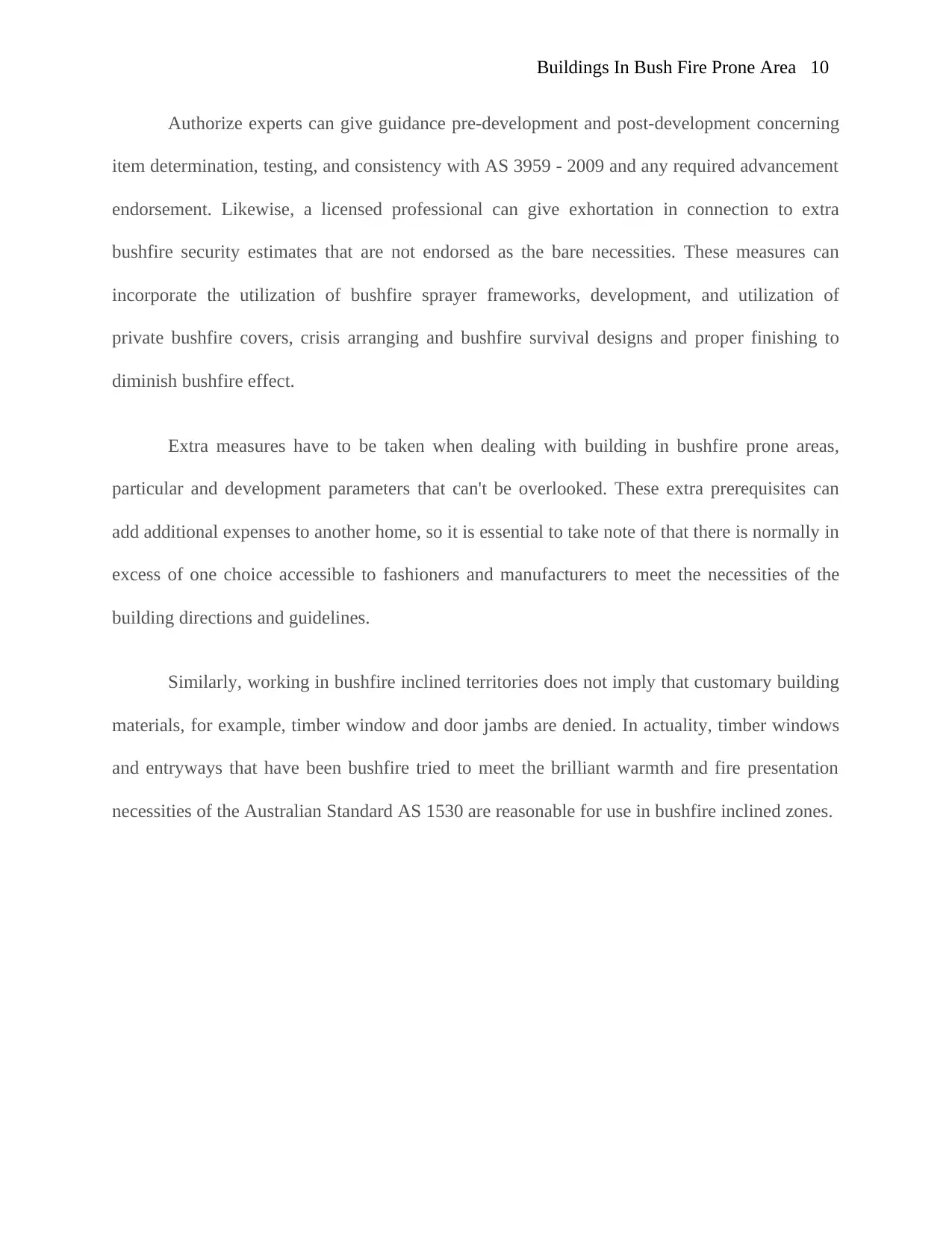
Buildings In Bush Fire Prone Area 10
Authorize experts can give guidance pre-development and post-development concerning
item determination, testing, and consistency with AS 3959 - 2009 and any required advancement
endorsement. Likewise, a licensed professional can give exhortation in connection to extra
bushfire security estimates that are not endorsed as the bare necessities. These measures can
incorporate the utilization of bushfire sprayer frameworks, development, and utilization of
private bushfire covers, crisis arranging and bushfire survival designs and proper finishing to
diminish bushfire effect.
Extra measures have to be taken when dealing with building in bushfire prone areas,
particular and development parameters that can't be overlooked. These extra prerequisites can
add additional expenses to another home, so it is essential to take note of that there is normally in
excess of one choice accessible to fashioners and manufacturers to meet the necessities of the
building directions and guidelines.
Similarly, working in bushfire inclined territories does not imply that customary building
materials, for example, timber window and door jambs are denied. In actuality, timber windows
and entryways that have been bushfire tried to meet the brilliant warmth and fire presentation
necessities of the Australian Standard AS 1530 are reasonable for use in bushfire inclined zones.
Authorize experts can give guidance pre-development and post-development concerning
item determination, testing, and consistency with AS 3959 - 2009 and any required advancement
endorsement. Likewise, a licensed professional can give exhortation in connection to extra
bushfire security estimates that are not endorsed as the bare necessities. These measures can
incorporate the utilization of bushfire sprayer frameworks, development, and utilization of
private bushfire covers, crisis arranging and bushfire survival designs and proper finishing to
diminish bushfire effect.
Extra measures have to be taken when dealing with building in bushfire prone areas,
particular and development parameters that can't be overlooked. These extra prerequisites can
add additional expenses to another home, so it is essential to take note of that there is normally in
excess of one choice accessible to fashioners and manufacturers to meet the necessities of the
building directions and guidelines.
Similarly, working in bushfire inclined territories does not imply that customary building
materials, for example, timber window and door jambs are denied. In actuality, timber windows
and entryways that have been bushfire tried to meet the brilliant warmth and fire presentation
necessities of the Australian Standard AS 1530 are reasonable for use in bushfire inclined zones.
Paraphrase This Document
Need a fresh take? Get an instant paraphrase of this document with our AI Paraphraser

Buildings In Bush Fire Prone Area 11
References
Armstrong, G. and Legge, S. (2011). The post-fire response of an obligate seeding Triodia
species (Poaceae) in the fire-prone Kimberley, north-west Australia. International Journal of
Wildland Fire, 20(8), p.974.
Barker, J. and Price, O. (2018). Positive severity feedback between consecutive fires in dry
eucalypt forests of southern Australia. Ecosphere, 9(3), p.e02110.
Cansler, C. and Larson, A. (2013). Prescribed Burning in Fire-Prone Landscapes. Fire Ecology,
9(3), pp.100-100.
Evans, S. (2007). Building in bush fire prone areas. Sydney, N.S.W.: NSW Rural Fire Service.
Harris, S., Mills, G. and Brown, T. (2017). Variability and drivers of extreme fire weather in fire-
prone areas of south-eastern Australia. International Journal of Wildland Fire, 26(3), p.177.
Lautenberger, C. (2017). Mapping areas at elevated risk of large-scale structure loss using Monte
Carlo simulation and wildland fire modeling. Fire Safety Journal, 91, pp.768-775.
Macindoe, L. and Leonard, J. (2011). Moisture content in timber decking exposed to bushfire
weather conditions. Fire and Materials, 36(1), pp.49-61.
Mundlak, G. (2013). Taking Path Dependence Seriously: Discussion of The Legal Construction
of Personal Work Relations. Jerusalem Review of Legal Studies, 7(1), pp.123-134.
Neale, T. (2017). ‘Are we wasting our time?’: bushfire practitioners and flammable futures in
northern Australia. Social & Cultural Geography, 19(4), pp.473-495.
Nguyen, Q., Ngo, T., Tran, P., Mendis, P., Aye, L. and Baduge, S. (2018). Fire resistance of a
prefabricated bushfire bunker using aerated concrete panels. Construction and Building
Materials, 174, pp.410-420.
Nguyen, Q., Ngo, T., Tran, P., Mendis, P., Aye, L. and Baduge, S. (2018). Fire resistance of a
prefabricated bushfire bunker using aerated concrete panels. Construction and Building
Materials, 174, pp.410-420.
References
Armstrong, G. and Legge, S. (2011). The post-fire response of an obligate seeding Triodia
species (Poaceae) in the fire-prone Kimberley, north-west Australia. International Journal of
Wildland Fire, 20(8), p.974.
Barker, J. and Price, O. (2018). Positive severity feedback between consecutive fires in dry
eucalypt forests of southern Australia. Ecosphere, 9(3), p.e02110.
Cansler, C. and Larson, A. (2013). Prescribed Burning in Fire-Prone Landscapes. Fire Ecology,
9(3), pp.100-100.
Evans, S. (2007). Building in bush fire prone areas. Sydney, N.S.W.: NSW Rural Fire Service.
Harris, S., Mills, G. and Brown, T. (2017). Variability and drivers of extreme fire weather in fire-
prone areas of south-eastern Australia. International Journal of Wildland Fire, 26(3), p.177.
Lautenberger, C. (2017). Mapping areas at elevated risk of large-scale structure loss using Monte
Carlo simulation and wildland fire modeling. Fire Safety Journal, 91, pp.768-775.
Macindoe, L. and Leonard, J. (2011). Moisture content in timber decking exposed to bushfire
weather conditions. Fire and Materials, 36(1), pp.49-61.
Mundlak, G. (2013). Taking Path Dependence Seriously: Discussion of The Legal Construction
of Personal Work Relations. Jerusalem Review of Legal Studies, 7(1), pp.123-134.
Neale, T. (2017). ‘Are we wasting our time?’: bushfire practitioners and flammable futures in
northern Australia. Social & Cultural Geography, 19(4), pp.473-495.
Nguyen, Q., Ngo, T., Tran, P., Mendis, P., Aye, L. and Baduge, S. (2018). Fire resistance of a
prefabricated bushfire bunker using aerated concrete panels. Construction and Building
Materials, 174, pp.410-420.
Nguyen, Q., Ngo, T., Tran, P., Mendis, P., Aye, L. and Baduge, S. (2018). Fire resistance of a
prefabricated bushfire bunker using aerated concrete panels. Construction and Building
Materials, 174, pp.410-420.
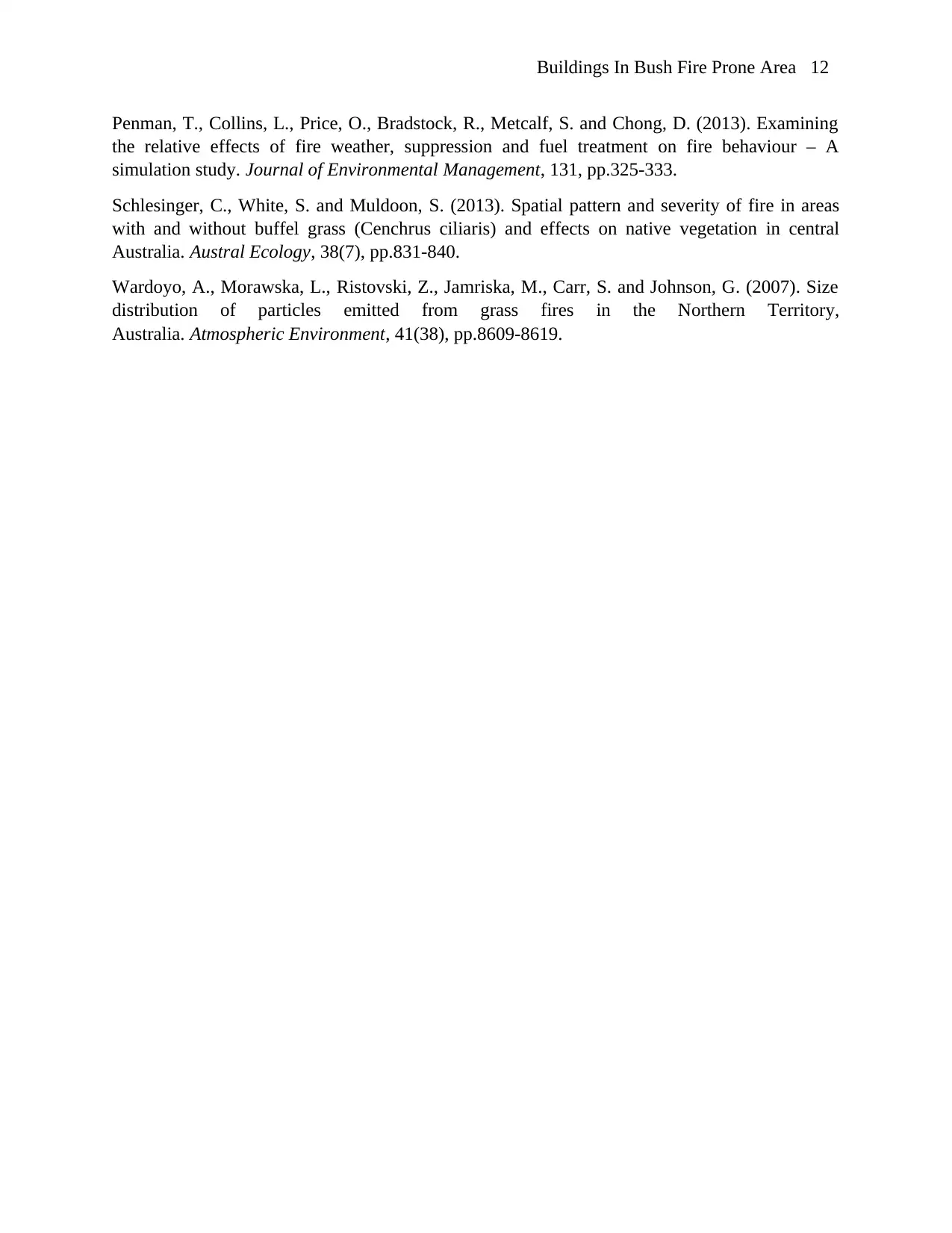
Buildings In Bush Fire Prone Area 12
Penman, T., Collins, L., Price, O., Bradstock, R., Metcalf, S. and Chong, D. (2013). Examining
the relative effects of fire weather, suppression and fuel treatment on fire behaviour – A
simulation study. Journal of Environmental Management, 131, pp.325-333.
Schlesinger, C., White, S. and Muldoon, S. (2013). Spatial pattern and severity of fire in areas
with and without buffel grass (Cenchrus ciliaris) and effects on native vegetation in central
Australia. Austral Ecology, 38(7), pp.831-840.
Wardoyo, A., Morawska, L., Ristovski, Z., Jamriska, M., Carr, S. and Johnson, G. (2007). Size
distribution of particles emitted from grass fires in the Northern Territory,
Australia. Atmospheric Environment, 41(38), pp.8609-8619.
Penman, T., Collins, L., Price, O., Bradstock, R., Metcalf, S. and Chong, D. (2013). Examining
the relative effects of fire weather, suppression and fuel treatment on fire behaviour – A
simulation study. Journal of Environmental Management, 131, pp.325-333.
Schlesinger, C., White, S. and Muldoon, S. (2013). Spatial pattern and severity of fire in areas
with and without buffel grass (Cenchrus ciliaris) and effects on native vegetation in central
Australia. Austral Ecology, 38(7), pp.831-840.
Wardoyo, A., Morawska, L., Ristovski, Z., Jamriska, M., Carr, S. and Johnson, G. (2007). Size
distribution of particles emitted from grass fires in the Northern Territory,
Australia. Atmospheric Environment, 41(38), pp.8609-8619.
⊘ This is a preview!⊘
Do you want full access?
Subscribe today to unlock all pages.

Trusted by 1+ million students worldwide
1 out of 12
Related Documents
Your All-in-One AI-Powered Toolkit for Academic Success.
+13062052269
info@desklib.com
Available 24*7 on WhatsApp / Email
![[object Object]](/_next/static/media/star-bottom.7253800d.svg)
Unlock your academic potential
Copyright © 2020–2025 A2Z Services. All Rights Reserved. Developed and managed by ZUCOL.





